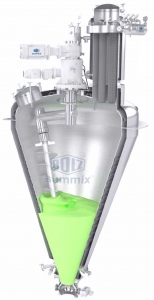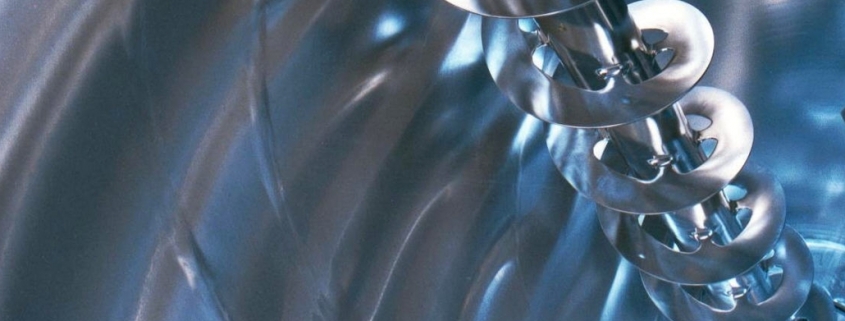Conical Screw Dryer – Perfect Mix by Gentle Agitation
Drying of fragile and sensitive solid products in the pharmaceutical, fine-chemical or food processing industry demands a protecting and gentle drying process. At the end only this will guarantee a reliable unfailing and reproducible quality of the finally dry product. In this respect ordinary common contact dryers soon are stretched to their limits. For this reason the conical screw dryer has well proven itself for drying applications with demanding products.
Low temperatures and low vacuum level – the vacuum-contact-drying by a conical screw dryer in any case is a very protecting process. The major reason why it is often selected for drying of fragile and sensitive bulk solid products in challenging applications of the pharmaceutical, fine-chemical and food processing industry. Other than during the precedent mechanical solid-liquid-separation by centrifugation or nutsche-filtration the use of precisely controlled big physical forces like centrifugal forces or pressure for the vacuum-contact-drying process does not have a dominating role or remarkable impact. Indeed a mechanically gentle treatment of the mostly crystallized powder is more important to maintain an optimized protecting process during the entire ongoing duration of the batch drying.
For that reason a really optimised dryer type is not identified by its perfectly high Nusselt- or Reynolds key figures, but more by its suitability to supply a reliable, reproducible and finally dry product of high quality, batch by batch and at any time. Continuous good quality and unrestricted usability of the mostly high-value bulk solids – like active substances of the pharmaceutical industry – do have a much higher priority than other factors like the sheer drying time or purely economic performance aspects.
The way of agitation makes the difference
For efficient drying of solid products in a contact dryer the agitator tool has to be well suited to frequently remove the partially dry product laying on the dryer wall away from the heated surfaces and perfectly mix it back into the semi-wet powder with quick homogenization of the entire batch. The continuous good mixing process is a must to guarantee that batch and bulk temperature are uniform and constant at any time.
Each individual type of contact dryer with a mechanical mixing tool is identified by a very unique and specific combination of two general mixing effects. The first is called macro-mixing, which is the obvious movement of bigger batch areas in relation to each other (also called convective mixing) and the micro-mixing which is the random change of individual particle locations to each other in much smaller scale (also called dispersion mixing). The diverse interaction of macro- and micro-mixing in each individual dryer type has its very unique influence on the drying behavior and drying result of each bulk solid or powder.
With ongoing duration of the drying process and declining product wetness -especially for the vacuum-drying process- the heat transfer resistances on the heated wall are no longer dominating the velocity of the drying process, but even more the mass transfer resistances inside the product particles itself. Type and intensity of mixing and agitation become less important. A homogeneous gentle agitation of the nearly dry batch, such as the conical screw dryer made by BOLZ-SUMMIX does perform, is sufficient to keep the lasting drying well going
Significant advantages compared to other dryer types
 Drying of temperature sensitive and often hygroscopic bulk solid products often goes on for many hours on a low temperature profile. A protective drying process can therefore well go along with a gentle product agitation and homogenization, whilst intensive macro-mixing by fast rotating mixing tools or massy product displacement very often will destroy the crystallized structure of the particles or overheat the product in a unwanted way. Dryer types with a very short clearance of the agitator to the vessel wall additionally can very easily and rapidly over-heat the product particles (at least partially) and further irreparably destroy the crucial character and mode of action of the valuable ingredients.
Drying of temperature sensitive and often hygroscopic bulk solid products often goes on for many hours on a low temperature profile. A protective drying process can therefore well go along with a gentle product agitation and homogenization, whilst intensive macro-mixing by fast rotating mixing tools or massy product displacement very often will destroy the crystallized structure of the particles or overheat the product in a unwanted way. Dryer types with a very short clearance of the agitator to the vessel wall additionally can very easily and rapidly over-heat the product particles (at least partially) and further irreparably destroy the crucial character and mode of action of the valuable ingredients.
Indeed an intensive product circulation within a single shaft dryer such as the traditional horizontal paddle dryer or the vertical shovel- and helix dryer will certainly offer a perfect mixing in the sense of convective mixing. But due to the wetness inside the product single parts of the batch will stick to each other, and so the micro-mixing – the exchange of individual particles itself- is very moderate and not sufficient.
For sticky, adhesive and very wet products this could easily result in a very poor mixing efficiency, hence the entire batch may only circulate with the mixing tool as the flow along the polished wall is not interrupted. To maintain the desired and necessary mixing effect at all, these dryer types will require a high level of drive energy. This will needless increase the operational cost compared to the conical screw dryer and will put additional mechanical stress onto the sensitive product.
Especially on intially very wet product, on a bulk with extremely fine particles or if the wetness encapsulated in the particles is driven to its surface by extremely high starting temperatures very rapidly a certain risk of agglomeration may be observed. Mechanically high forces by intensive mixing and agitation in this case may facilitate the creation of different sized, however compacted spherical balls (“balling”) or build-up of a solidified and crusty layer on the heated vessel wall. This for example could be observed with foto-chemicals, color pigments or toner material. The granulated spherical particles do enclose the residual moisture inside the balls, the wall layer solidifies by the wall temperature and very much limits the achievable heat transfer rates. All this will increase the total drying time and limit the product quality as the hard balls must be broken into homogeneous powder by a downstream milling process.
Remaining product layers on the wall and agitator do not only mean lost of valuable solid, but are also difficult to be removed by a standard spray cleaning process. The conical screw dryer with its unique and gentle mixing principle in this respect can offer some remarkable advantages.
Handling sensitive solids
Depending on the type and level of wetness, many organic solids also show this critical behaviour during drying. For most of the industrial crystallized solids such as Peptides or Vitamines this can be illustrated by a fix correlation between level of wetness and temperature of the bulk, a graph called the “sticky curve”. With decreasing wetness the risk of agglomeration, balling and wall layers diminishes and allows for higher mechanical and thermal stresses. In consequence the starting heat temperature, initially set very carefully, and the primary low speed of the agitation may be increased when drying continues.
The art of gentle drying
Not only for processing of sensitive API’s and intermediates a careful setting of guiding drying parameters may be recommendable. Very specific for each product and type of wetness this should include for a controlled ramping of the heating temperature as well as for a gentle -yet intensive- product circulation and agitation of the partly wet product, a mode of operation such as the conical screw dryer does achieve simply by its basic design.
Not the entire batch will be agitated at a time, only a selected portion of the product bulk will be vertically lifted bottom-to-top by the mixing screw running close along the conical wall, passing through the mostly stationary bulk bed. With the entire batch it will frequently flow back into the bottom simply by gravity where the entire gentle product circulation starts again and again. The slow rotation of the orbital arm gives a slightly horizontal motion and in combination with the screw and the gravity will maintain a smooth 3-dimensional product circulation. Shearing forces along the long line on the outer diameter of the rotating screw blades secure a gentle but intensive micro-mixing, hence the product can easily evade bigger forces by escaping towards the dryer center. This even will be optimized by the conical shape of the tapered mixing screw, at the same time minimizing product wear and the need of power for mechanical agitation.



